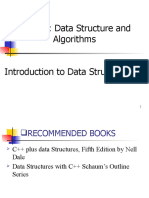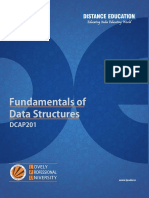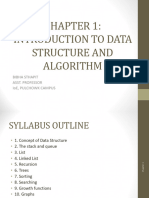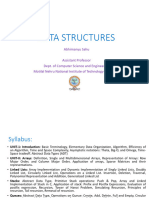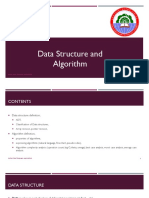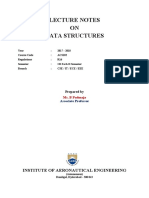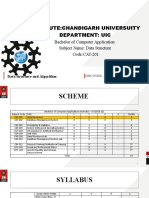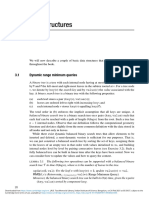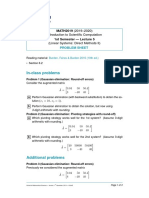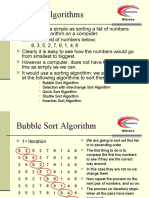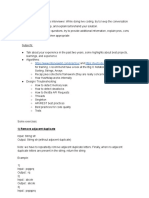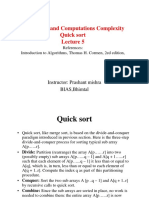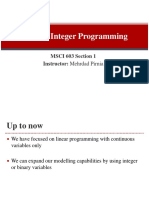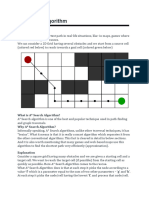Design and Analysis of Algorithms
CSC201
Shahid Hussain
1
� Books
Introduction to Algorithms (Second Edition) T.H. Cormen, C.E.
Leiserson, R.N. Rivest, C. Stein - McGraw Hill - MIT Press,
2001
Computer Algorithms: Introduction to Design and Analysis,
Sara Baase, Allen Van Gelder, Prentice hall, 1999
Introduction to Algorithms, A Creative Approach, Udi Manber,
Addison-Wesley, 1989.
2
� Course Outline
Data Structure (Recap)
Introduction of Algorithms and its notation
Basics algorithms and its analysis
Asymptotic notations
Recursion and recurrence relations
Divide-and-conquer approach
Sorting; Search trees
Hashing
3
� Course Outline (Cont !!!)
Binary Search Tree
Graph algorithms; Shortest paths; Network flow; Disjoint Sets;
Polynomial and matrix calculations;
Greedy approach
Dynamic programming
String matching algorithms
Amortized analysis
NP complete problems
4
� Data Structure Recap
5
� Data Structure Recap
The term data refer to collection of facts or figures
There are two ways to process and manipulate data.
– Data Structure
Refer to temporary and manipulation of data
E.g. Variables and array of a procedural language
– Database
Refer to Permanent storage and manipulation of data
E.g. MS Access, Foxpro etc
Data structure is way to process and manipulate data through set of operations
6
� Data Structure Recap
Consider following C language program
Main() Execute first time:
Output will 8
{
int a, b, c;
a=3;
Execute second and
b=5
other times.
// OR cin>>a>>b; Again Output will 8
c=a+b;
cout<<“Sum=“<<c;
}
What concluded here
7
� Data Structure Recap
Type of Data Structures according to the presentation of data (i.e. How data is
presented)
1. Linear Data Structure
1. Sequential Data Structures
1. Array
2. Queue
3. Stack
2. Pointer Data Structure (Linked List)
2. Non Linear Data Structure
1. Tree
2. Graphs
8
� Data Structure Recap
Type of Data Structures according to memory representation
1. Logical Data Structure
1. Map data according to partition structure of memory
2. E.g. One Dimensional Array
2. Physical Data Structures
1. Can not map data easily according to partition structure of memory
2. E.g Two Dimensional Array, Tree etc
3. A special method is needed to convert physical Data Structure into Logical, such as dope
vector is used to convert 2-D into 1-D.
9
� Data Structure Recap
Common operation for all Data Structure are.
– Insert ( Insert new item/element into a data structure)
– Delete (Remove an item from Data Structure)
– Sort (Use to arrange all items in either ascending or descending order)
– Search (Use to locate an element/item of a data structure)
– Merge (Use to combine the elements of more than one similarly data structure
– Traversing (Scanning or visit of each element for view etc)
10
� Data Structure Recap
Array
– Linear and sequential
– Array is combination of homogenous element with
N Consecutive index numbers (Such as 1,2,3,4, . . .)
Successive memory location (such as 102, 104, 106 . . . )
– Successive memory location depend on the size of data types, such as in C language size of integer data type is 2
bytes)
– Two types of array are commonly used.
One Dimensional (1-D) ( Only logical data structure)
Two Dimensional (2-D) (Physical Data structure)
– Dope Vector method is used to convert 2-D into 1-D
11
� Data Structure Recap
Stack Data Structure
– Linear and sequential
– Work on following principles
LIFO (Last In First Out) OR Total
FILO (First In Last Out) Size=
– Two Conditions are N=5
Overflow (It will occur when stack is full and you try to insert new element)
Underflow (It will occur when stack is empty and you try to delete an element)
12
� Data Structure Recap
Queue Data Structure
– Linear and sequential
– Work on following principles
FIFO (First In First Out) OR
LILO (Last In Last Out)
– Two Conditions are
Overflow (It will occur when Queue is full and you try to insert new element)
Underflow (It will occur when Queue is empty and you try to delete an element)
– Type of Queues are
Circular Queue
Priority Queue
Double Ended Queue
13
� Data Structure Recap
Linked List Data Structure
– Linear and Pointer
– Each element of linked list represented through a node which have two , three or more parts
depends on types of linked list
– Type of Linked List are
One way linked List
Two Way linked List (Doubly Linked List)
14
� Data Structure Recap
Tree Data Structure
– Non Linear Data Structure
– Each element of linked list represented through a node which have two , three or more parts depends on
types of tree
– Type of Linked List are
General Tree
Binary Tree
B+ Tree
Balance and Unbalance Tree
15
� Data Structure Recap
Graph Data Structure
– Non Linear Data Structure
– Each element of linked list represented through a node
– Type of Graph are
Connected Graph
Weighted Graph
16
� Summary
Data structure is way for storing and manipulation of data
Two main categories or types of data structure are linear and non linear data structure.
In case of memory representation, data structure are of two types logical and physical data structure.
Insert, Delete, Merge, Sort and search are common operations for all types of data structure.
Array, Stack and Queue are linear and sequential data structures.
Linked List is linear and pointer based data structure.
Tree and graphs are non linear data structures
17
� What to be Next
In Next lecture, we will discuss algorithms, its characteristics and
convention.
18



